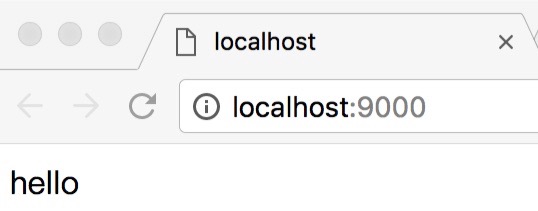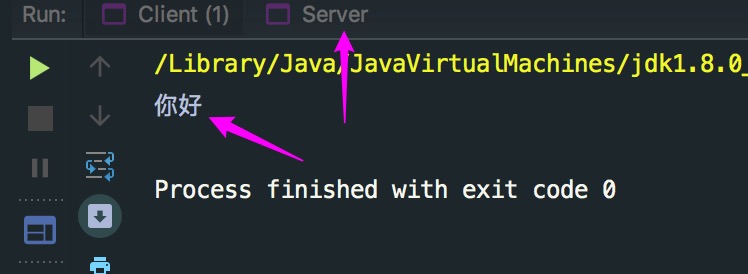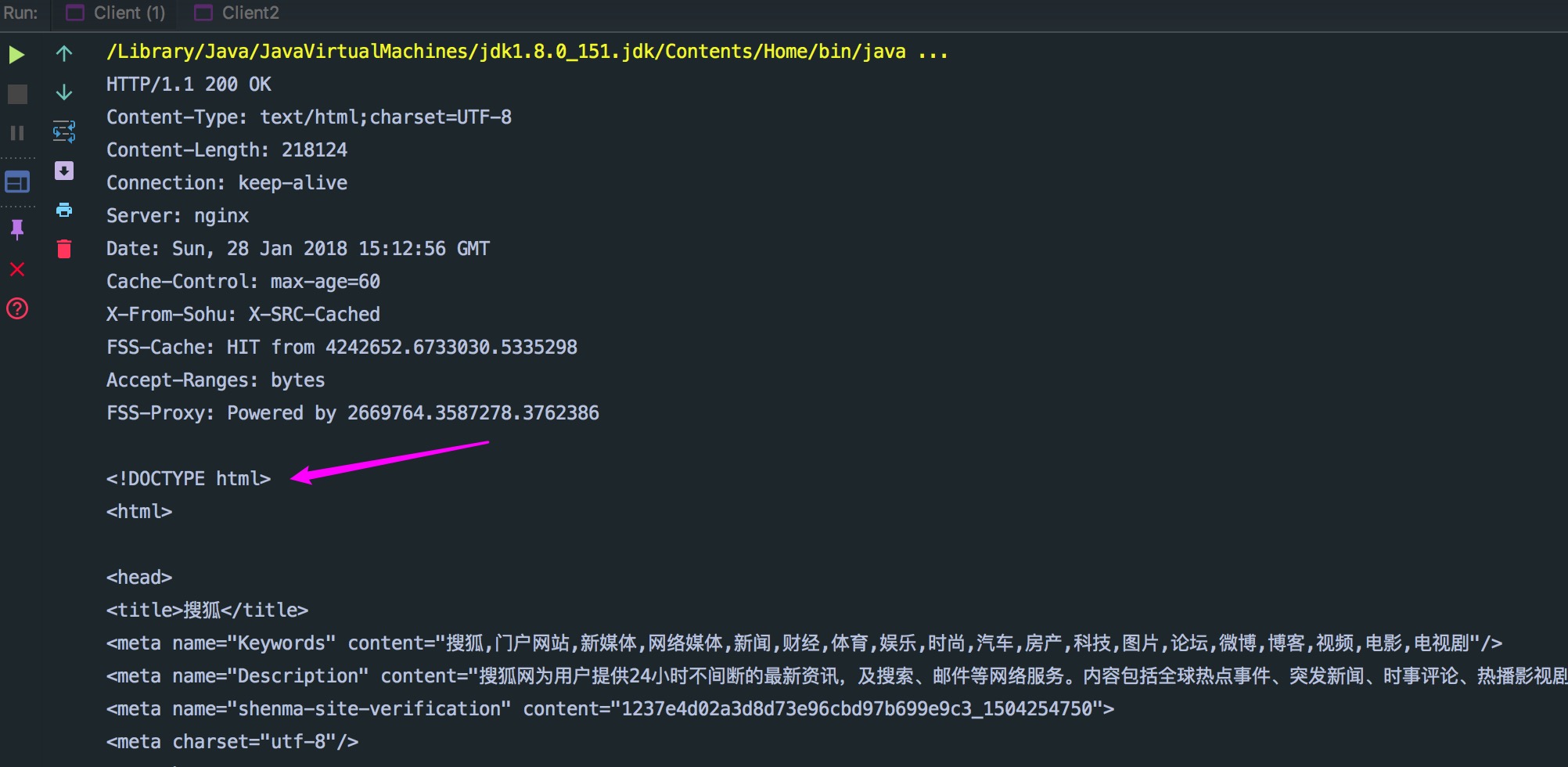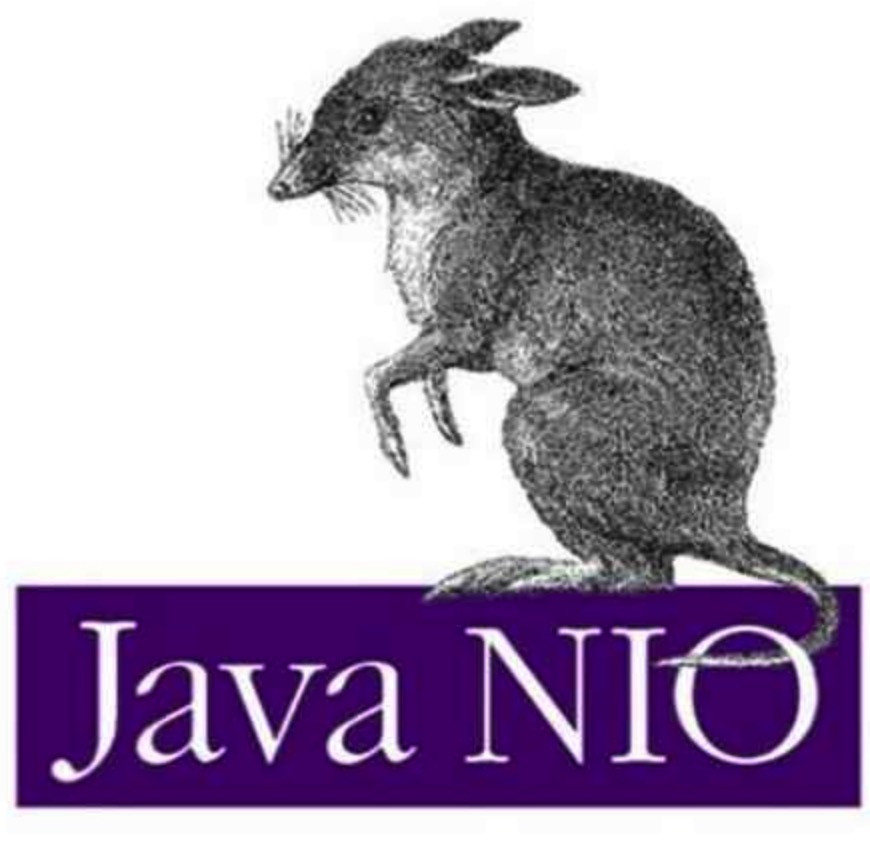从Socket入门到BIO,NIO,multiplexing,AIO
Socket入门
最简单的Server端读取Client端内容的demo
public class Server {
public static void main(String [] args) throws Exception{
ServerSocket ss = new ServerSocket(9000);
Socket s = ss.accept();
InputStream input = s.getInputStream();
byte[] bytes = new byte[1024];
int len = input.read(bytes);
System.out.println(new String(bytes,0,len));
}
}
打开浏览器,输入localhost:9000

可以看到控制台输出了如下内容(HTTP请求头)

或者命令行输入:telnet localhost 9000 , 然后按下ctrl+] 然后再输入: send 发送的内容 , 然后就可以再IDEA控制台看到send的内容了.
但是现在手头是Mac系统,不知道为啥send不好使....windows下测过,肯定好使.
最简单的Server端写入到Client端内容的demo
public class Server2 {
public static void main(String[] args) throws Exception {
ServerSocket ssocket = new ServerSocket(9000);
Socket socket = ssocket.accept();
OutputStream os = socket.getOutputStream();
os.write("http/1.0 200 OK\nContent-Type:text/html;charset:GBK\n\nhello".getBytes());
os.flush();
os.close();
}
}
可以在浏览器输入localhost:9000来请求内容 , http响应头的那部分会被浏览器解析掉.所以只输出一段hello

或者可以使用telnet localhost 9000来访问, 得到的结果就是那段写入的内容

最简单的Client端写入到Server端的Demo
public class Client {
public static void main(String[] args) throws Exception{
Socket socket = new Socket("localhost",9000);
OutputStream output = socket.getOutputStream();
output.write("你好".getBytes());
output.close();
socket.close();
}
}
注:需要先运行上面的Server类, 然后再运行这个Client. 然后再点击Server的控制台标签, 就会发现Server类的控制台输已经出了"你好"字样.

最简单的用Client端来模拟浏览器http请求Demo
用socket作为Client来模拟浏览器访问网站, 来获取网站的html内容.以www.sohu.com 为例...为什么选sohu呢? 你试试百度,会报302....
public class Client2 {
public static void main(String[] args) throws Exception {
Socket socket = new Socket("www.sohu.com", 80);
InputStream input = socket.getInputStream();
OutputStream output = socket.getOutputStream();
StringBuilder str = new StringBuilder();
//http协议中请求行,必须,不然不会被识别为HTTP
str.append("GET / HTTP/1.1\r\n");
//http协议中的请求头
str.append("Host: www.sohu.com\r\n");
str.append("Connection: Keep-Alive\r\n");
// 用于模拟浏览器的user-agent
str.append("user-agent: Mozilla/5.0 (Macintosh; Intel Mac OS X 10_13_1) AppleWebKit/537.36 (KHTML, like Gecko) Chrome/63.0.3239.132 Safari/537.36\r\n");
//这里一定要一个回车换行,表示消息头完,不然服务器会一直等待,认为客户端没发送完
str.append("\r\n");
byte[] bytes = new byte[1024];
output.write(str.toString().getBytes());
while (true) {
int len = input.read(bytes);
if (len > 0) {
String result = new String(bytes, 0, len);
System.out.println(result);
} else {
break;
}
}
}
}
运行后, 前面是http响应头, 后面是html代码

改进Server类, 循环读取
前面提到的"最简单的Server端读取Client端内容的demo"这段代码, 也就是Server类. 其实不管客户端发来多少内容, 都只能读取1024字节以内的数据. 因为代码就是这么写的....
下面进行改进, 让他循环读取, 直到读完为止.
public class Server3 {
public static void main(String[] args) throws Exception {
ServerSocket ss = new ServerSocket(9000);
Socket s = ss.accept();
InputStream input = s.getInputStream();
byte[] bytes = new byte[1024];
while (true) {
int len = input.read(bytes);
// 如果读到了内容,说明得输出啊
if (len > 0) {
System.out.println(new String(bytes, 0, len));
}
// 如果没读取到内容,或者没读满bytes数组 说明读完了, 不用再读下一次了, 该退出循环了.
if (len < bytes.length) {
break;
}
}
}
}
可以配合着用前文中的Client类来进行测试.先跑Server来监听端口, 再运行Client发送请求. 去看Server类的控制台是否输出相应的内容.
将服务器改为循环运行
之前是Server响应一个客户端就终止了,这回用while(true)来让Server不停地进行服务.
public class Server4 {
public static void main(String[] args) throws Exception {
ServerSocket ss = new ServerSocket(9000);
while (true) {
Socket s = ss.accept();
InputStream input = s.getInputStream();
byte[] bytes = new byte[1024];
while (true) {
int len = input.read(bytes);
// 如果读到了内容,说明得输出啊
if (len > 0) {
System.out.println(new String(bytes, 0, len));
}
// 如果没读取到内容,或者没读满bytes数组 说明读完了, 不用再读下一次了, 该退出循环了.
if (len < bytes.length) {
break;
}
}
}
}
}
可以配合着用前文中的Client类来进行测试.先跑Server来监听端口, 再运行Client发送请求. 去看Server类的控制台是否输出相应的内容.
Server运行一次就行, 一直在提供服务. 而Client这回可以运行多次了, Client运行几次, Server的控制台下就会收到几个'你好'.
BIO
同步阻塞IO, 每个线程都处理着一个客户端.客户端与线程数是1:1
public class Server5 {
public static void main(String[] args) throws Exception {
ServerSocket ss = new ServerSocket(9000);
System.out.println("服务端启动");
// 循环着监听
while (true) {
Socket s = ss.accept();
System.out.println("接收到客户端");
// 一旦接收到客户端,就开一个线程
new Thread(() -> {
//为了让代码简短,try多包一些代码...
try {
InputStream input = s.getInputStream();
OutputStream output = s.getOutputStream();
byte[] bytes = new byte[1024];
while (true) {
int len = input.read(bytes);
// 如果读到了内容,说明得输出啊
if (len > 0) {
System.out.println(new String(bytes, 0, len));
}
// 如果没读取到内容,或者没读满bytes数组 说明读完了, 不用再读下一次了, 该退出循环了.
if (len < bytes.length) {
break;
}
}
output.write("http/1.1 200 OK\nContent-Type:text/html;charset:GBK\n\nhello".getBytes());
output.flush();
input.close();
output.close();
} catch (Exception e) {
e.printStackTrace();
} finally {
//...其实close应该出现在这里...
System.out.println("断开连接");
}
}).start();
}
}
}
可以在浏览器上用两个标签栏来访问localhost:9000来进行测试.
PIO
伪异步IO,为了避免Server5无限制地开一个新线程,使用线程池来统一管理线程.
public class Server6 {
public static void main(String[] args) throws Exception {
ServerSocket ss = new ServerSocket(9000);
System.out.println("服务端启动");
ExecutorService pool = Executors.newFixedThreadPool(40);
// 循环着监听
while (true) {
Socket s = ss.accept();
System.out.println("接收到客户端");
// 一旦接收到客户端,就放入线程池
pool.submit(() -> {
//为了让代码简短,try多包一些代码...
try {
InputStream input = s.getInputStream();
OutputStream output = s.getOutputStream();
byte[] bytes = new byte[1024];
while (true) {
int len = input.read(bytes);
// 如果读到了内容,说明得输出啊
if (len > 0) {
System.out.println(new String(bytes, 0, len));
}
// 如果没读取到内容,或者没读满bytes数组 说明读完了, 不用再读下一次了, 该退出循环了.
if (len < bytes.length) {
break;
}
}
output.write("http/1.1 200 OK\nContent-Type:text/html;charset:GBK\n\nhello".getBytes());
output.flush();
input.close();
output.close();
} catch (Exception e) {
e.printStackTrace();
} finally {
//...其实close应该出现在这里...
System.out.println("断开连接");
}
});
}
}
}
NIO
首先推荐一本书,讲的详细:

nio博客 http://ifeve.com/java-nio-all/ ,这个更适合快速入门,但原理最好还是看书..讲的很详细
所以相关原理就不在这里粘贴了....再整理也没人家讲的全面易懂,这本书还是非常推荐看的,一开始我就是在网上看各种博客(当时也知道这本书), 但直到耐下心看了这本书,才发现很多地方这里讲的非常详细, 这本书是基于api讲的, 以后需要分析看源码的话还是借助博客更好一些,网上有很多大神的源码分析
public class NIOServer {
private static int BUFFER_SIZE = 1024;
private static int PORT = 9000;
public static void main(String[] args) throws Exception {
Selector selector = Selector.open();
ServerSocketChannel serverSocketChannel = ServerSocketChannel.open();
serverSocketChannel.socket().bind(new InetSocketAddress(PORT));
serverSocketChannel.configureBlocking(false);
serverSocketChannel.register(selector, SelectionKey.OP_ACCEPT);
while (true) {
selector.select();
Iterator<SelectionKey> iter = selector.selectedKeys().iterator();
while (iter.hasNext()) {
SelectionKey key = iter.next();
iter.remove();
if (key.isAcceptable()) {
SocketChannel socketChannle = serverSocketChannel.accept();
socketChannle.configureBlocking(false);
socketChannle.register(selector, SelectionKey.OP_READ, ByteBuffer.allocate(BUFFER_SIZE));
} else if (key.isReadable()) {
SocketChannel socketChannel = (SocketChannel) key.channel();
ByteBuffer buf = (ByteBuffer) key.attachment();
// 读浏览器发送的HTTP请求
long bytesRead = socketChannel.read(buf);
while (bytesRead > 0) {
buf.flip();
while (buf.hasRemaining()) {
System.out.print((char) buf.get());
}
System.out.println();
buf.clear();
bytesRead = socketChannel.read(buf);
}
//向浏览器返回HTTP请求
buf.put("http/1.1 200 OK\nContent-Type:text/html;charset:GBK\n\nhello".getBytes());
socketChannel = (SocketChannel) key.channel();
buf.flip();
while (buf.hasRemaining()) {
socketChannel.write(buf);
}
// 关闭
socketChannel.close();//这样浏览器才不继续拉取
key.cancel();
}
}
}
}
}
然后再浏览器中访问localhost:9000即可看到"hello"
或者用普通SocketClient来访问
或者用如下的NIOClient访问:
public class NIOClient {
public static void main(String[] args) throws Exception {
ByteBuffer buffer = ByteBuffer.allocate(1024);
SocketChannel socketChannel = SocketChannel.open();
socketChannel.configureBlocking(false);
socketChannel.connect(new InetSocketAddress("localhost", 9000));
if (socketChannel.finishConnect()) {
//向服务器写入
for (int i = 0; i < 3; i++) {
String info = "hello:<" + i + ">";
buffer.clear();
buffer.put(info.getBytes());
buffer.flip();
while (buffer.hasRemaining()) {
socketChannel.write(buffer);
}
}
//从服务器读取
buffer.clear();
long bytesRead = socketChannel.read(buffer);
while (bytesRead > 0) {
buffer.flip();
while (buffer.hasRemaining()) {
System.out.print((char) buffer.get());
}
System.out.println();
buffer.clear();
bytesRead = socketChannel.read(buffer);
}
}
}
}
未完待续....
从Socket入门到BIO,NIO,multiplexing,AIO的更多相关文章
- Java BIO NIO 与 AIO
回顾 上一章我们介绍了操作系统层面的 IO 模型. 阻塞 IO 模型. 非阻塞 IO 模型. IO 复用模型. 信号驱动 IO 模型(用的不多,知道个概念就行). 异步 IO 模型. 并且介绍了 IO ...
- 从Socket入门到BIO,PIO,NIO,multiplexing,AIO(未完待续)
Socket入门 最简单的Server端读取Client端内容的demo public class Server { public static void main(String [] args) t ...
- BIO,NIO与AIO的区别
Java NIO : 同步非阻塞,服务器实现模式为一个请求一个线程,即客户端发送的连接请求都会注册到多路复用器上,多路复用器轮询到连接有I/O请求时才启动一个线程进行处理.Java AIO(NIO.2 ...
- Java的BIO,NIO和AIO的区别于演进
作者:公众号:我是攻城师 前言 Java里面的IO模型种类较多,主要包括BIO,NIO和AIO,每个IO模型都有不一样的地方,那么这些IO模型是如何演变呢,底层的原理又是怎样的呢? 本文我们就来聊聊. ...
- Socket网络通信——IO、NIO、AIO介绍以及区别
一 基本概念 Socket又称"套接字",应用程序通常通过"套接字"向网路发出请求或者应答网络请求. Socket和ServerSocket类位于java.ne ...
- 关于BIO NIO和AIO的理解
转载自 :http://blog.csdn.net/anxpp/article/details/51512200 1.BIO编程 1.1.传统的BIO编程 网络编程的基本模型是C/S模型,即两个进程间 ...
- BIO、NIO、AIO入门认识
同步.异步.阻塞.非阻塞概念理解. 同步: 比如在执行某个逻辑业务,在没有得到结果之前一直处于等待阻塞状态,得到结果后才继续执行 异步: 比如在执行某个逻辑业务,在没有得到结果可以去干其他的事情,等待 ...
- JAVA SOCKET 通信总结 BIO、NIO、AIO ( NIO 2) 的区别和总结
1 同步 指的是用户进程触发IO操作并等待或者轮询的去查看IO操作是否就绪 自己上街买衣服,自己亲自干这件事,别的事干不了.2 异步 异步是指用户进程触发IO操作以后便开始做自己的事情,而当IO操作已 ...
- 也谈BIO | NIO | AIO (Java版--转)
关于BIO | NIO | AIO的讨论一直存在,有时候也很容易让人混淆,就我的理解,给出一个解释: BIO | NIO | AIO,本身的描述都是在Java语言的基础上的.而描述IO,我们需要从两个 ...
随机推荐
- Luogu P1596 [USACO10OCT]湖计数Lake Counting
题目描述 Due to recent rains, water has pooled in various places in Farmer John's field, which is repres ...
- Linux socket网络编程基础 tcp和udp
Socket TCP网络通信编程 首先,服务器端需要做以下准备工作: (1)调用socket()函数.建立socket对象,指定通信协议. (2)调用bind()函数.将创建的socket对象与当前主 ...
- python函数式编程之装饰器(二)
以前用装饰器,都是定义好了装饰器后,使用@装饰器名的方法写入被装饰函数的正上方 在这里,定义的装饰器都是没有参数的 在定义装饰器的函数的时候,没有在括号里定义参数,这就叫做无参装饰器 既然有无参装饰器 ...
- 快速排序(QuickSort)
1.算法思想 快速排序是一种划分交换排序.它采用了一种分治的策略,通常称其为分治法(Divide-and-ConquerMethod). (1) 分治法的基本思想 分治法的基本思想是:将原 ...
- dojo实现省份地市级联报错(二)
- Extjs 4.0 Tab页
1.JSON代码 Ext.MyTabs=Ext.extend(Ext.TabPanel ,{ xtype:"tabpanel", activeTab:2, width:694, h ...
- VxWorks镜像简介
VxWorks镜像可分为三类: 可加载型VxWorks镜像:存储在开发机上,运行在板上RAM中 基于ROM的VxWorks镜像:存储在板上ROM,运行在板上RAM中 ROM驻留的VxWor ...
- 第一个bug
话不多说自己遇到的第一个小程序bug 需要渲染渲染多重元素,这个没什么.but当你要获取这个大样式的id进行各种操作时,你需要每一个子节点都加上data-=""属性这样就很麻烦了, ...
- 【BZOJ1415】【NOI2005】聪聪和可可(动态规划,数学期望)
[BZOJ1415][NOI2005]聪聪和可可(动态规划,数学期望) 题面 BZOJ 题解 先预处理出当可可在某个点,聪聪在某个点时 聪聪会往哪里走 然后记忆化搜索一下就好了 #include< ...
- 【BZOJ3670】动物园(KMP算法)
[BZOJ3670]动物园(KMP算法) 题面 BZOJ 题解 神TM阅读理解题 看完题目之后 想暴力: 搞个倍增数组来跳\(next\) 每次暴跳\(next\) 复杂度\(O(Tnlogn)\) ...
